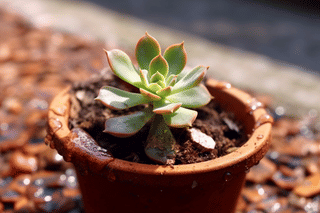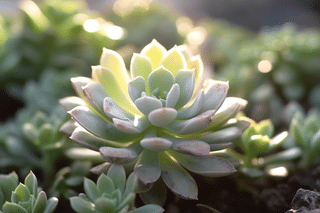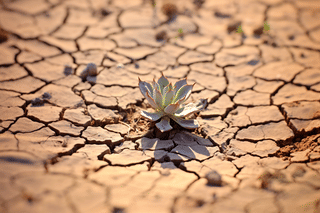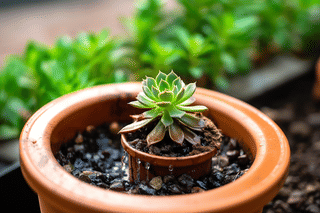Overwatered vs Underwatered Succulent: How to tell the difference
Having trouble figuring out if your succulent is overwatered or underwatered? In this plant care guide, I'll share my tips on how to tell the difference and give you practical solutions for reviving your succulent. Don't let your plant suffer any longer – join me in discovering the secrets of succulent care!
Are you concerned that your succulent may be overwatered or underwatered, but you're not sure which? Knowing the difference between the two is key to providing optimal care and keeping your plant healthy. In this guide, we'll cover the signs of an overwatered or underwatered succulent and how to tell them apart to provide the best care for your plant.
These are the topics we're going to look at in this plant care guide:
Let's learn more about the watering needs of a succulent and how we can recognize the signs of overwatering or underwatering a succulent.
Understanding Succulent Water Requirements
Overwatering and underwatering are the most common mistakes plant owners make that can harm succulents, so it's essential to know how much water your succulent needs.
Succulents are plants that are adapted to survive in dry environments, where there is very little rain. These plants store water in their leaves, stems, and roots, which allows them to survive for long periods without water. However, this does not mean that they don't need water at all. Like all plants, succulents need water to grow and thrive.
The amount of water a succulent needs depends on various factors such as the species, the size of the plant, the pot size, the soil type, and the environmental conditions. In general, succulents need less water than other plants, and they prefer well-draining soil that allows excess water to drain away quickly.
So what happens when a succulent gets too much or too little water? Let's explore that a little more!
Effects of Overwatering and Underwatering
Watering your succulent correctly is one of the most important parts of keeping it healthy. It's essential to understand how much water a succulent needs and what happens when it gets too much or too little. In this section, we'll look at the effects of overwatering and underwatering on a succulent so you can provide the best care for your plant.
Impact on Succulent Growth
Overwatering can lead to root rot and fungal infections, which can cause the plant to wilt and eventually die. On the other hand, underwatering can cause the plant to become dehydrated and shriveled.
When succulents are overwatered, their roots become waterlogged, which can lead to root rot. This condition occurs when the roots are unable to absorb oxygen and nutrients due to the excessive presence of water. The roots begin to decay, and the plant loses its ability to absorb water and nutrients, leading to stunted growth and eventual death.
Underwatering, on the other hand, can cause the succulent to become dehydrated. When a succulent is underwatered, it will begin to lose its plumpness and become shriveled. This is because the plant is losing water faster than it can absorb it. As a result, the plant will stop growing and may eventually die.
Long-Term Consequences
Overwatering and underwatering can have long-term consequences on the health of a succulent. If a succulent is overwatered, it may develop fungal infections that can spread to other plants. Additionally, the root rot caused by overwatering can make it difficult for the plant to absorb nutrients, leading to stunted growth and eventual death.
Underwatering can also have long-term consequences on the health of a succulent. If a succulent is underwatered for an extended period, it may become permanently damaged. The plant may develop brown spots, and its leaves may turn yellow or brown. In severe cases, the plant may die.
So how do you know if your succulent is overwatered or underwatered? Let's look a little more closely at the signs your succulent might show you if it's too wet or too dry.
Identifying Overwatered and Underwatered Succulents
Knowing how to identify an overwatered or underwatered succulent is essential for providing the best possible care. In this section, we will look at some of the signs that indicate whether your succulent has been overwatered or underwatered, so you can adjust your watering schedule accordingly and keep your plant healthy.
Signs of Overwatering
Overwatering is one of the most common reasons why succulents die. It's important to know the signs of overwatering to prevent your succulents from suffering. Here are some signs to look out for:
- Soft and mushy leaves
- Yellowing leaves
- Brown or black spots on the leaves
- Leaves falling off easily
- Root rot (a foul smell of the soil)
- Mold or fungus growth on the soil surface
If you notice any of these signs, you may be overwatering your succulent. In the next section, we'll look at how we can treat your succulent when you've noticed that it's suffering from being overwated.
Have you not seen any of these sins on your succulent, but something is not going well? Your succulent might be too dry. Let's look at the signs that your succulent might be underwatered.
Signs of Underwatering
Underwatering is another common problem that succulent owners face. Succulents are adapted to survive in very dry conditions, but they still need some water to thrive. Here are some signs that your succulent may be underwatered:
- Wrinkled or shriveled leaves
- Dry and brittle leaves
- Leaves falling off easily
- Slow growth
- Brown or crispy leaves
If you notice any of these signs, your succulent may be thirsty. Water it thoroughly and adjust your watering schedule to prevent underwatering in the future.
Now that you know the signs of overwatering and underwatering, it's time to help your plant recover from these watering issues and prevent any watering issues in the future.
Prevention and Treatment
Watering your succulent correctly is essential for keeping it healthy and happy. Now that you've figured out whether you've watered your succulent too much or too little, we can look at how to help your succulent recover. In this section, we'll look at tips for preventing issues in the future and treatment so you can provide the best care for your plant.
Treatment for Overwatered Succulents
If I notice that my succulent is overwatered, I immediately stop watering and remove it from the soil. I then gently remove any rotted or mushy roots and let the plant dry out completely for a few days. Once the plant has dried out, I repot it in fresh, well-draining soil and resume watering only when the soil is completely dry.
Preventing Overwatering
To prevent overwatering in the future, I always make sure to use well-draining soil and a pot with drainage holes. Succulents are adapted to survive in arid environments, so they don't need a lot of water. I also make sure to let the soil dry out completely before watering again. It's better to underwater than overwater, as succulents can tolerate dry soil for longer periods.
Treatment for Underwatered Succulents
If I notice that my succulent is underwatered, I immediately water it thoroughly and make sure the water reaches the roots. I then wait for the soil to dry out completely before watering again. It's important not to overwater the plant after it has been underwatered, as this can cause root rot.
Preventing Underwatering
To prevent underwatering from happening again, I check the soil moisture regularly by sticking my finger about an inch into the soil. It's ideal to water your plant when the soil is completely dry. This is a little difficult to check by just sticking your finger in the soil, so there is an additional trick you can use: Lift the pot and feel its weight. If the pot is very light, the soil is likely completely dry. If it still feels a little heavy, wait a few more days and try again. This takes a bit of practice, but I've found it the easiest way to figure out if the soil is completely dry.
If the soil is completely dry, it's time to water. I also make sure to water thoroughly, so that the water reaches the roots of the plant. It's important not to let the plant sit in standing water, as this can cause root rot. This is why a drainage hole in the pot is so important.
Proper Watering Techniques for Succulents
Now that we've looked at ways to help your succulent recover and some ways to prevent future watering issues, it's good to look at some watering techniques to water your succulent perfectly every time. With these tips, you will be able to keep your succulent looking its best!
Watering in the morning and evening
An important factor to consider is the time of day when watering succulents. It is best to water them early in the morning or late in the evening when the temperature is cooler. This will prevent the water from evaporating too quickly and ensure that the plant has time to absorb the water before the sun becomes too hot.
Bottom watering
Besides the normal watering of your plant from the top, you can also choose to water your succulent from the bottom. This technique involves putting the pot with a drainage hole in a bowl that has water in it. The soil will absorb the moisture through the drainage hole and makes sure the roots get evenly watered.
Let the pot stand in the bowl with water for 5-10 minutes, then take the pot out of the bowl and let the excess moisture drain from the pot for 5-10 minutes. The soil will now have absorbed all the moisture it can hold and any excess moisture has escaped the pot.
Thank you for reading this post! I hope it helps you to keep your plants healthy and beautiful! If you're looking for more guides on specific plants, you can always request a plant guide to get a guide for the plant you have trouble with.
Test your plant care knowledge
Quiz completed!
Want to learn more? Sign up for my newsletter to receive free tips in your inbox!
Sign up now!














